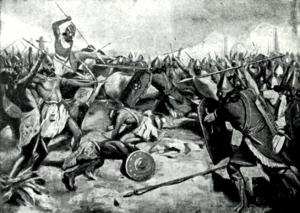Battle of Carchemish facts for kids
Quick facts for kids Battle of Carchemish |
|||||||
|---|---|---|---|---|---|---|---|
| Part of the Egyptian–Babylonian wars | |||||||
 The Battle of Carchemish, as depicted in Hutchinson's Story of the Nations (1900) |
|||||||
|
|||||||
| Belligerents | |||||||
| Twenty-sixth Dynasty of Egypt Remnants of the army of the former Neo-Assyrian Empire |
Neo-Babylonian Empire Median Empire Persians Scythian Kingdom (?) |
||||||
| Commanders and leaders | |||||||
| Necho II | Nebuchadnezzar II Cyaxares(?) |
||||||
| Casualties and losses | |||||||
| Heavy | Minimal | ||||||
The Battle of Carchemish was a big fight that happened around 605 BC. It took place near a city called Carchemish. On one side were the armies of Egypt and what was left of the Assyrian Empire. On the other side were the armies of Babylonia, who were joined by the Medes, Persians, and Scythians.
At the time, Nebuchadnezzar II was the main commander for Babylonia. His father, Nabopolassar, was still the king. Nebuchadnezzar became king of Babylon just a few weeks after this important battle.
Contents
Why the Battle Happened
The Fall of Assyria
The Assyrian Empire was once very powerful. But by 612 BC, its capital city, Nineveh, was attacked. It was taken over by a group of allies, including the Medes, Scythians, and Babylonians.
After this defeat, the Assyrians moved their capital to a city called Harran. But in 609 BC, Harran was also captured by the same allies. This was the end of the Assyrian Empire.
Egypt Helps Assyria
Even though Egypt used to be controlled by Assyria, they decided to help the remaining Assyrian army. The Assyrian soldiers joined forces with Egypt at Carchemish. This city was under Egyptian rule and was located on the Euphrates River.
The Egyptian army, led by Pharaoh Necho II, marched to help the Assyrian King Ashur-uballit II. They wanted to fight against the Babylonians.
A Delay at Megiddo
On their way, the Egyptian army faced a delay. King Josiah of Judah tried to stop them at a place called Megiddo. In the Battle of Megiddo, King Josiah was killed, and his army was defeated.
After this, the Egyptians and Assyrians crossed the Euphrates River together. They tried to take back Harran, but they failed. So, they went back to northwestern Assyria, which is now part of northeastern Syria.
The Battle of Carchemish
A Major Clash
The Egyptian and Assyrian forces met the powerful army of Babylonia and Media at Carchemish. The Babylonian and Median army was led by Nebuchadnezzar II.
The combined Egyptian and Assyrian forces were completely defeated. The Assyrian Empire officially ended as an independent power. Egypt also lost a lot of its strength and was no longer a major power in the Ancient Near East.
Babylonia's Rise
After this big victory in 605 BC, Babylonia became very strong and rich. It reached its best economic times.
What Records Say
The Nebuchadnezzar Chronicle
We know about this battle from ancient writings. One important record is called the Nebuchadnezzar Chronicle. It is now kept in the British Museum.
This chronicle says that Nebuchadnezzar "crossed the river to go against the Egyptian army which lay in Karchemiš." It explains that "They fought with each other and the Egyptian army withdrew before him. He accomplished their defeat, decisively."
The chronicle also mentions that the Babylonian troops chased the rest of the Egyptian army. They caught them in the area of Hamath and defeated them. Not a single Egyptian soldier escaped back to their home country. At that time, Nebuchadnezzar took control of the whole area of Hamath.
The Bible's Account
The battle is also mentioned and described in the Bible. You can find it in the Book of Jeremiah.
Different Views
Historians usually believe that Pharaoh Necho II was fighting to support the remaining Assyrian forces. However, an ancient writer named Flavius Josephus had a different idea. In his book, Antiquities of the Jews, he wrote that Necho entered the battle to take advantage of the situation. He thought Necho wanted to gain power because the Assyrian forces had been defeated.
See also
- Siege of Kimuhu
- Battle of Quramati

